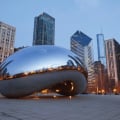In addition to being the perfect place to jog, Millennium Park hosts free sports sessions every summer.
Millennium Park was due to open in 2000, to mark the start of the new millennium, but technical problems delayed its opening until 2004. What was once a vast, unused wasteland is now a large park, invaded by walkers as soon as the sun comes out.
The metal structure that can be seen from afar is the Jay Pritzker Pavilion, an open stage designed by architect Frank Gehry, whose paternity is obvious.
Anyone familiar with his work (such as the Fondation Louis Vuitton in Paris, or the Guggenheim Museum in Bilbao, Spain) will recognize the curved lines and flake-like metal plates used to create the back wall of the stage, a perfect acoustic object that transmits sound of unrivalled quality right down to the last few meters of the lawn. The structure resembles a metal wall that has been twisted and torn by strong winds; its lines are tortuous and intricate. The latticework of metal tubes thrown over the lawn has several functions: technically, it supports small high-tech loudspeakers with impressive sound quality, but it also defines the space, so that even spectators far from the stage feel included in what's happening up front. Seven thousand people can stand beneath the structure, and a further four thousand can be seated facing the stage.
The metal flake bridge that spans Columbus Drive is the Pedestrian Bridge, also designed by Frank Gehry. It snakes above the cars to take pedestrians towards Grant Park. Its shape has been designed to attenuate the noise of road traffic, so that it doesn't interfere with the musical performances taking place nearby.
At the center of Millennium Park is sculptor Anish Kapoor's Cloud Gate, a giant 110-ton 3D mirror in the shape of a drop of liquid mercury or a large bean. In fact, that's what Chicagoans call it: the " bean ". Its curves reflect the Chicago skyline - its buildings - as well as walkers, the gridded ground, and it offers infinite possibilities for photographers. The metal surface of the giant bean was polished for five months in early 2004 to remove lines and jack marks; today, it is perfectly smooth and the eye is only drawn to the distorted reflections.
To the south of the Pritzker Pavilion, the Lurie Garden is a strolling area divided into two floral compositions: to the east, the plants are representative of the natural environment of the shores of the Great Lakes, with small trees and small hills; to the west, the vegetation represents Chicago rising from its ashes after the Great Fire of 1871: plants no taller than 60 cm, whose blossoms follow one another progressively from spring to autumn.
Wrigley Square is home to a Greek peristyle, a replica of the one that existed on the same spot fifty years earlier, and which was demolished when the Grant underground parking lot was built.
It's an arched colonnade of twenty-four columns, whose stones were imported from Indiana and France, with a fountain in the center. It is 20% smaller than the original 1917 structure, for reasons of weight: you don't want to end up with a Greek peristyle on top of your car in the underground parking lot!
North of the Pritzker Pavilion, the Harris Theater for music and dance hosts performances by the city's twelve theater companies, including the Chicago Opera Theater, the Mexican Fine Arts Center Museum, the Muntu Dance Theatre and Lincoln Park's Old Town School of Folk Music. The visible part of the structure is very small, most of the theater being underground, in accordance with a law that prohibits the construction of buildings in Grant Park.
Open on Michigan Avenue, the McCormick Tribune Plaza serves as a skating rink in winter and as a giant terrace in summer for the restaurants embedded beneath the Cloud Gate terrace. The skating rink is open from November to March, weather permitting.
The Crown Fountain, southwest of Millennium Park, is a creation by Spanish artist Jaume Plensa. Two 17 m-high glass brick cubes face each other, their feet in a few millimetres of water. A waterfall cascades down their four sides. At regular intervals, the giant LED screen behind the glass bricks wakes up, displaying the portrait of one of the thousand Chicagoans filmed for the installation. His mouth forms an "O", and water spurts out at the same moment. There's nothing funnier in summer than watching children (and a few adults) squeeze under the jet, screaming! In a way, they're virtual gargoyles. The thickness of the water between the cubes reflects the portraits, and it's thin enough that you can walk on it without filling your shoes. According to the artist, it should feel like walking on water. At the fountain's inauguration, children threw themselves under the water jets, while parents looked on in dismay. The next day, everyone came back with their beach towels and stretched out on the grass around the fountain.
The Nichols Bridgeway was designed by Italian architect Renzo Piano and inaugurated in 2009. It is 198 metres long and links the park to The Art Institute of Chicago.
Did you know? This review was written by our professional authors.
Members' reviews on MILLENNIUM PARK
The ratings and reviews below reflect the subjective opinions of members and not the opinion of The Little Witty.








